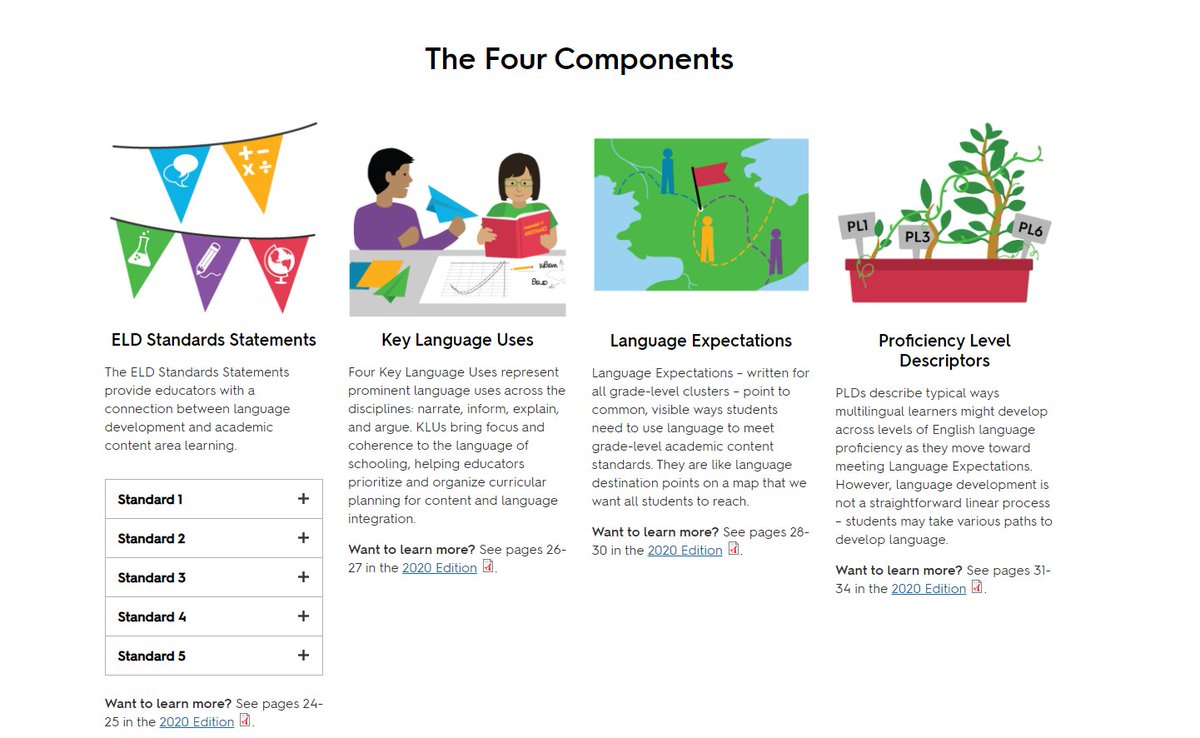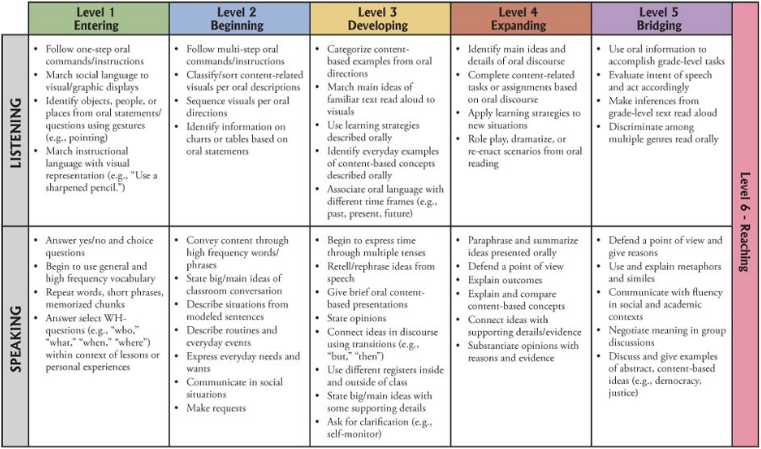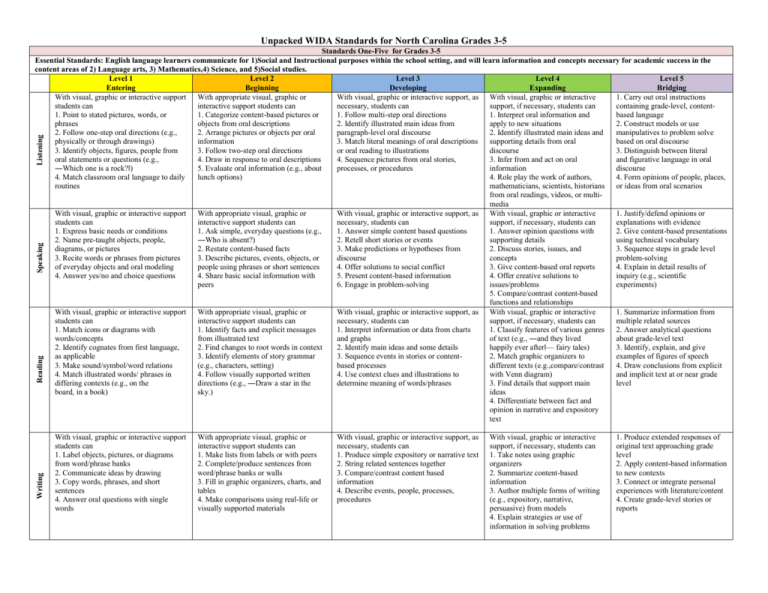The Wida stands for world-class instructional design and assessment. However, wida has five English language proficiency areas that students must acquire. At first, the social and instructional language is probably the most foundational. Now, we know most students spend their time socializing, so that language is going to develop first. Therefore, when we are talking about instructional language, then we start moving specifically into the language.

Wida language standards
However, they are the language of arts, the language of mathematics, the language of science and the language of social studies. So, we need to recognize that we each have specific academic vocabulary. Then, we require students to have to function within the classroom. Additionally, the proficiency level ranging from one to six will give you an idea. However, the idea of where the language learners enter and when they leave.
So the first level of course is entering, then emerging, developing, expanding, bridging and reaching. Now, level three is where we can see students begin a little bit more progressing. Hence, they are going to try some new things. But moving into level four and five, we will have to push them a little more. Moreover, this is where they will be able to start digging deeper with the language. Thus, they are getting a little bit more proficient and more comfortable with them.
Wida standards examples
For example, we want level one students to analyze. Thus, it would look like they would be able to label a drawing. Hence, on Next level two, we are moving into emerging, they might describe the stages of something level. Therefore level three, now we can start to use those details. For level four and five, we are beginning to see more social side work. Moreover, this is where they can discuss and hold a conversation or start reproducing stories. However, this is just one small example of an academic language. So, the word analyzed will allow the students to produce something they are analyzing depending on their proficiency level.

Wida standards 2020
Subsequently, there are four crucial big ideas for the 2020 edition. Now each of the four ideas converges around this centralized idea. Moreover, this is the idea of supporting k-12 multilingual language learners to find success in school. Next, the four big ideas are student-centric. However, they are culturally and linguistically responsive, and they focus on students from an asset-based or strength-based approach. Now, the first one is the notion of teaching language and content together. However, the multilingual language learners really bring several advantages, both linguistic and cultural capital, to classrooms. Therefore, the multilingual language learners should be able to access content in multimodal ways. Hence, this is really beyond a text-based engagement. Moreover, learning and extending with rich opportunities are not only content connections but also connections regarding language.

Wida eld standards 2020 edition
Also, there are opportunities for students to engage with content. Hence, that are graphics, supported visually or even digitally to ensure equitable access to information. Now, the focus is also an integration here with the integration of content and language. However, it is best to ensure students make those connections to content through rich learning and language opportunities. Moreover, there are some other pieces around that equity for multilingual learners and that collaboration amongst key stakeholders. Additionally, the last thing is the functional approach to language development. Thus, the standards emphasize language and opportunity are here to serve both social and emotional purposes.

So, in the 2020 edition, the focus is on the notion that language is used for various audiences. Now, the functional approach to language development for students is helping them make choices to make meaning. However, we know students interact with other students in the classroom environment. Moreover, they also have the opportunities to use language in rich, authentic dialogue. Next, it ensures students gain language proficiency from these rich experiences.
Wida standards 2020 framework
However, the philosophical approach continues to remain the foundation of the wider framework. Now, it emphasizes that asset-based approach to the potential of our multilingual language learners. Next, the five WIDA ELD standard statements remain the same. Hence, the six levels of language proficiency remain the same. But there is a continuum because students learn languages at different rates and speeds.

Wida standards Illinois
Since 2004, Illinois has been a member of WIDA (World-Class Instructional Design and Assessment). However, WIDA is a group of states dedicated to developing and implementing high standards. Additionally, it also dedicates to fair educational opportunities for English language learners. Moreover, it provides states with programming for identifying and evaluating the English language growth of their English learners. Hence, this is done on an annual basis. State agency of the State ELL resources is the Illinois State Board of Education. Next, the Statewide Standards-Based Assessment is the Illinois assessment.
More than 197,000 English language learners attended Illinois schools during the 2016-2017 academic year. However, Spanish, Arabic, Polish, Chinese, and Urdu were the top five languages spoken by ELLs in Illinois. Thus, it was for the 2014-2015 school year.
Wida standards Alabama
Since 2004, Alabama has been a member of WIDA. Additionally, More than twenty seven-hundred English language newcomers attended Alabama faculties at some stage in the 2016-2017 educational year. Hence, Spanish, Korean, Arabic, Chinese, and Vietnamese were the top five languages spoken by ELLs in Alabama. Thus, it was during the 2014-2015 school year. Next, the State agency of Alabama is Alabama State Department of Education (ALSDE). Also ELP standards of Alabama are WIDA English Language Proficiency Standards.
Wida standards NJ
Since 2005, New Jersey has been a member of WIDA. Moreover, more than 70,500 English language learners attended New Jersey schools during the 2016-2017 school year. Subsequently, Spanish, Arabic, Chinese, Portuguese, and Korean were the top five languages spoken by ELLs in New Jersey for the 2014-2015 school year. Next, the state agency of New Jersey is the New Jersey Department of Education.
Wida standards TN
However, more than 43,000 English language learners attended Tennessee schools during the 2016-17 school year. Next, Spanish, Arabic, Somali, Chinese, and Kurdish were the top five languages. Hence, these languages were spoken by ELLs in Tennessee for the 2014-2015 school years. Then, the state agency of Tennessee is the Tennessee Department of Education. Moreover, WIDA language development standards are used in Tennessee and instructional assistance is provided through professional development and guidance manuals.
Wida standards chart 1
| Level 1 Entering | Beginning Level 2 | Level 3 developing | Expanding Level 4 | Level 5 bridging | |
| Reading | • Associate letters with sounds
and objects. • Next, match content-related objects/ pictures to words Identify common symbols, signs, and words. • Next, recognize principles of print. • Now, find single word responses to WH- questions (e.g, who,” “what, when,” “where”) related to illustrated text. • Now, use picture dictionaries/ illustrated glossaries.
|
Sequence illustrated text of fictional and non-fictional
events. • Next, locate main ideas in a series of simple sentences. Find information from text structure (e.g., titles, graphs, glossary). However, follow text read aloud (e.g., tapes, teacher, paired-readings) Sort/group pre-taught words/ phrases. • Next, use pre-taught vocabulary (eg, word banks) to complete simple sentences. • Next, use Li to support L2 (e.g. cognates). • Now, use bilingual dictionaries and glossaries.
|
However, identify topic sentences,
main ideas, and details in paragraphs Identify multiple meanings of words in context (eg, ‘cell,” “table”). • Next, use context clues. • Make predictions based on illustrated text. • Now, identify frequently used affixes and root words to make extract meaning (e.g. “un-‘re-ed”). • Next, differentiate between fact and opinion. • Now, answer questions about explicit information in texts. • Next, use English dictionaries and glossaries.
|
• Now, order paragraphs
Identify summaries of passages Identify figurative language (e.g., “dark as night”) Interpret adapted classics or modified text. • Next, match cause to effect. • Next, identify specific language of different genres and informational texts. • However, use an array of strategies (e.g., skim and scan for information).
|
Differentiate and apply
multiple meanings of words/ phrases. • Now, apply strategies to new situations. • Next, infer meaning from modified grade-level text. • Next, critique material and support argument. • However, sort grade-level text by genre. |
Wida standards chart 2
| Writing | • Draw content-related
Pictures. Produce high frequency Words. •Next, Label pictures and graphs. •Next, create vocabulary/concept cards. Generate lists from pre taught words/ phrases and word banks (e.g., create a menu from a list of food groups). |
• Complete pattern sentences.
• Now, extend sentence starters with original ideas. • Now, connect simple sentences. • Next, complete graphic organizers forms with personal information. • Next, respond to yes/no, choice, and some WH- questions. |
Produce short paragraphs
with main ideas and some details (e.g., column notes). • Now, create compound sentences leg, with conjunctions). • Now, explain steps in problem solving • Next, compare contrast information, events, characters. Next, give opinions, preferences, and reactions along with reasons |
• Create multiple-paragraph
essays. • Justify ideas. • Next, produce content-related reports. • Now, use details/examples to support ideas. • Now, use transition words to create cohesive passages. • Next, compose intro/body/ conclusion. • Next, paraphrase or summarize text. • Take notes (e.g., for research). |
• Create expository text to
explain graphs/charts. • Now, produce research reports using multiple sources/ citations. • Begin using analogies. • Next, critique literary essays or articles. |
Some frequently asked questions
What are the WIDA language standards?
Language of arts, language of mathematics, language of science and the language of social studies are the Wida language standards.
What does WIDA stand for?
Wida stands for world class instructional design and assessment.
What is the purpose of the WIDA standards?
To measure the ability and progress of the English language learners is the purpose of the WIDA standards.
What are the 4 language domains in the WIDA standards?
Reading, writing, speaking and listening are the 4 domains in the WIDA standards.
How many Wida standards are there?
There are five Wida standards present.
What are the four key language uses?
Inform, explain, narrate and argue are the four key language uses.
What are the five WIDA ELD proficiency levels?
Entering, emerging, developing, expanding, bridging and reaching are the five Wida ELD proficiency levels.



